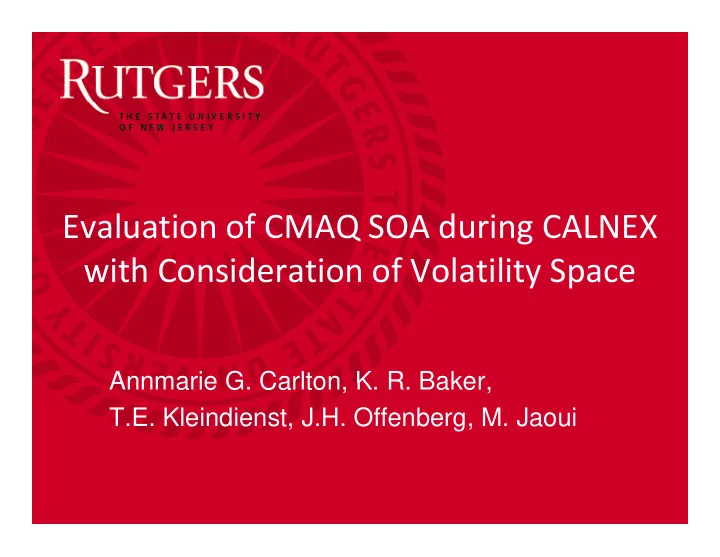

Evaluation of CMAQ SOA during CALNEX g with Consideration of Volatility Space Annmarie G Carlton K R Baker Annmarie G. Carlton, K. R. Baker, T.E. Kleindienst, J.H. Offenberg, M. Jaoui
California Nexus R Roof top of CalTech (Pasadena) f t f C lT h (P d ) B k Bakersfield (San Joaquin Valley) fi ld (S J i V ll ) For additional model details see Kelly et al. Poster
Motivation CMAQ exhibits a persistent negative bias in OA mass prediction. Q p g p Community consensus that it is a consequence of 2 o processes. Missing VOCs? More SV products? Possibly, but even when precursors are perfectly known (e.g., Parikh et al., (2010)) models still fail. Missing Processes? Missing Processes? Application of theory needs expanding: “Like” into “Like” means polar organic compounds into polar solvents (water) (Parikh et al., 2010; Wayne et al., 2010; Pankow and Barsanti, 2009) 009) Total carbon comparisons are insufficient to guide effective mechanism d development. Evaluation of theory and chemical tracers is critical. l t E l ti f th d h i l t i iti l
accumulation mode cloud water ∙ OH SV_ALK long organic PM alkanes • CMAQ employs Odum type Q SV_TOL1 p y yp AALK AALK SV TOL2 SV_TOL2 hi h high-yield i ld parameterizations for SOA aromatics AORGC ATOL1, ATOL2 ution SV_XYL1 AOLGA low-yield ·OH ·OH/NO SV XYL2 SV_XYL2 dissolu aromatics AXYL1, AXYL2 ATOL3 • The saturation vapor pressures of AXYL3 ABNZ1, ABNZ2 partitioning species in CMAQ span 5 p g p Q p SV_BNZ1 ABNZ3 SV BNZ2 SV_BNZ2 glyoxal POA orders of magnitude benzene methylglyoxal AOLGB ATRP1, ATRP2 ·OH/HO 2 SV_TRP1 ASQT AISO3 SV_TRP2 SV TRP2 H + • CMAQ partitioning species retain monoterpene AISO1, AISO2 SV_SQT chemical idenity and can be traced to y VOCs · OH,O 3 , or NO 3 , 3 , 3 sesquiterpenes VOC precursor – important SSIONS SSIONS SV_ISO1, SV_ISO2 IONS IONS IONS consideration for source attribution isoprene isoprene EMISSI EMIS EMIS EMISSI EMISSI Pathways do not contribute to SOA Carlton et al., ES&T 2010
Model Formulations to Model SOA Model Formulations to Model SOA alkanes aromatics isoprene monoterpenes sesquiterpenes http://www.epa.gov/AMD/ModelDevelopment/aerosolModule.html
Absorptive ‐ Partitioning Theory ( ) ⎡ ⎤ − Q Q RT C 1 N a T e f 760 RT v = = + aer , i s TSP om ⎢ ⎥ K ° ° , ζ ζ P , i 6 ⎣ ⎣ ⎦ ⎦ C C TPM TPM p p 1600 1600 MW MW 10 10 gas , i L i om i organic-phase surface adsorption p absorption absorption C 760 RT = = aer , i K ° ζ ζ om , i 6 C C M M p p MW MW 10 10 gas , i o L , i om i Expressed partitioning behavior of each compound as a function of temperature and organic phase composition function of temperature and organic-phase composition M o is the organic-phase mass concentration Notation differs slightly from primary reference Notation differs slightly from primary reference – Ref: Pankow, Atmos. Env. (1994) – Slide courtesy of P. Bhave
Theory: applied to toluene SOA modeling Odum type 2 product Odum type 2 product Ng et al. (2007) Volatility basis set Hildebrandt et al., (2009) P Parikh et al., AE , 2011 ikh t l AE 2011 CMAQ and GEOS ‐ Chem have multiphase (heterogeneous) SOA processes
Modeling Overview • May ‐ July 1, 2010 episode • CMAQ v4.7.1 (N2a) • CB05 & AERO5 • • WRF v3 2 (MCIP v3 6) WRF v3.2 (MCIP v3.6) • BEIS v3.14 • WRF 2 m temperature and WRF shortwave downward radiation • Horizontal grid cell size = 4 km • 2005v2 NEI anthropogenic • NX = 236, NY = 317 emissions for U.S. • Lambert projection centered at ( ‐ 97,40) with true latitudes 33 and 45 • Domain origin ( ‐ 2416 km, ‐ 832 km) • • Mexico emissions based on 1999 Mexico emissions based on 1999 inventory (Mexico a minimal influence during CalNex). For additional model details see Kelly et al. Poster
Conclusions Missing gaps in CMAQ’s SOA volatility distribution when CB05 is g g p y employed. Organic mass “aging” (VOC � SV_VOC � SV_OA � LV_OA) assumptions need some re ‐ visiting ‐ # of carbons in SV species ≠ to parent VOC # of carbons in SV species ≠ to parent VOC ‐ assigned OM:OC ratios should be calculated for individual, representative chemicals , p Chemical SOA tracers are underpredicted for all measurable species at 2 CA locations: urban and rural i 2 CA l i b d l – Some chemical identity is lost during oligomerization – Tracers are not conservative or OM:OC is not constant from chamber to field – Gas phase VOC/SV_VOC precursors mixing ratios are not correct,
Acknowledgements • • James Kelly James Kelly • Rich Mason • Laura Reynolds, Allan Beidler, James Beidler, Chris Allen
Recommend
More recommend